Exploring Schutz's FIRO Theory and Group Systems Theory in Practice
VerifiedAdded on 2022/10/17
|7
|1909
|10
Essay
AI Summary
This essay provides an in-depth analysis of two prominent theories related to group work: Schutz's FIRO theory and the Group Systems theory. The introduction establishes the significance of group work in enhancing organizational output and fostering essential skills like communication and collaboration. The essay delves into FIRO theory, explaining its focus on interpersonal needs such as inclusion, control, and affection, and its application in predicting group dynamics. It also examines the Group Systems theory, highlighting its emphasis on the interconnectedness and changing nature of group relations within an organization. A critical comparison of both theories is provided, emphasizing the differences in their approach towards understanding group dynamics and interpersonal relationships. The essay concludes by highlighting the practical implications of both theories, suggesting their application in enhancing team performance and achieving organizational objectives.
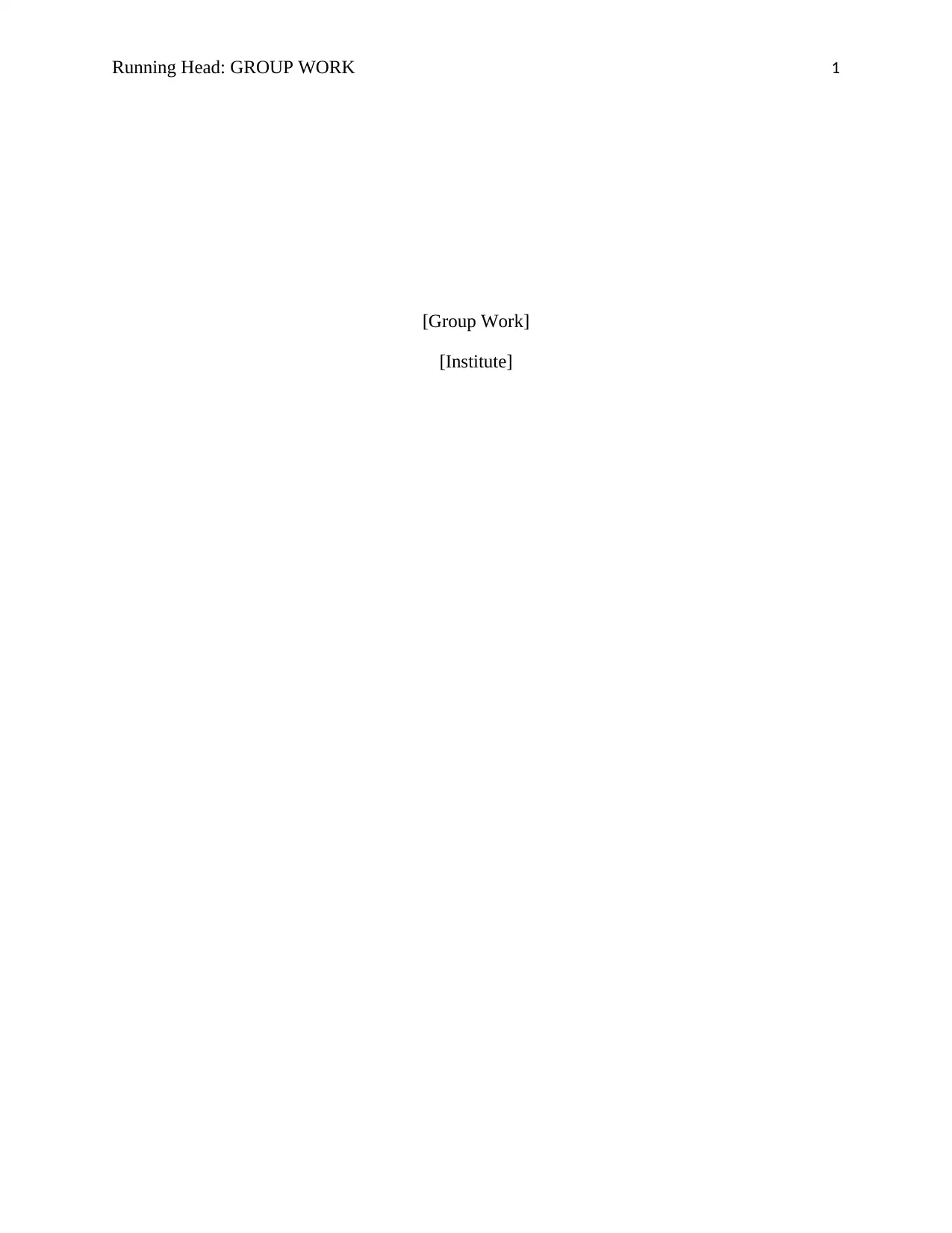
Running Head: GROUP WORK 1
[Group Work]
[Institute]
[Group Work]
[Institute]
Paraphrase This Document
Need a fresh take? Get an instant paraphrase of this document with our AI Paraphraser

GROUP WORK 2
INTRODUCTION
Group work refers to the voluntary association of the staff members who gets advantages
from the cooperative learning leading to enhance the overall output of the task. The purpose of
group work is to reduce the individual differences, develop different skills like communication,
collaborative, etc and generate conforming standards of behavior. The employees of the
organization working in group create feelings of mutual interdependence and sense of
belongingness. Group work results to enhance the performance, skills and relationships of the
workers at the firm leading to higher productivity and profitability (Wilson, Brickman & Brame,
2018). In context to this, the present essay includes two theories regarding the group work. The
two theories considered for this essay are Schutz’s FIRO theory and Group system’s theory. It
also consists of critical analysis of the theories.
Will Schutz introduced FIRO theory in 1958 in his book FIRO: A three dimensional
theory of interpersonal behavior. In this theory, FIRO represents Fundamental Interpersonal
Relations Orientation. The major purpose of Schutz behind generating this theory was to
evaluate and predict the communication or engagement between the individuals for developing
highly productive groups. This theory has been highly researched by the experts and proved to be
simple, powerful and comprehensive (Furnham & Crump, 2015). Along with this, FIRO theory
described about the three levels of human interactions which are behavior, feelings and self-
concept. This theory pays attention on the interpersonal aspects of the group. This theory
depends upon the belief that when some individuals create a group then there are three major
interpersonal requirements they used to look for: inclusion, affection and openness and control.
However, a measuring instrument was created by Schutz later with the help of basic theory,
known as FIRO-B (FIRO Theory. 2019).
According to the Group system’s theory, when some persons join together for any reason
then they develop a group or strong relation and becomes a living, breathing and enhancing
entity. This theory offers an understanding and working with groups in a company because it
moves beyond the attention on interpersonal exchanges. This theory is motivated by the
engagements or communications in the groups and with their external working environment
(Burden, 2018). The boundaries and power structure of the companies can affect the decisions
and resources allocated for the group work. System theory provides understanding related to the
INTRODUCTION
Group work refers to the voluntary association of the staff members who gets advantages
from the cooperative learning leading to enhance the overall output of the task. The purpose of
group work is to reduce the individual differences, develop different skills like communication,
collaborative, etc and generate conforming standards of behavior. The employees of the
organization working in group create feelings of mutual interdependence and sense of
belongingness. Group work results to enhance the performance, skills and relationships of the
workers at the firm leading to higher productivity and profitability (Wilson, Brickman & Brame,
2018). In context to this, the present essay includes two theories regarding the group work. The
two theories considered for this essay are Schutz’s FIRO theory and Group system’s theory. It
also consists of critical analysis of the theories.
Will Schutz introduced FIRO theory in 1958 in his book FIRO: A three dimensional
theory of interpersonal behavior. In this theory, FIRO represents Fundamental Interpersonal
Relations Orientation. The major purpose of Schutz behind generating this theory was to
evaluate and predict the communication or engagement between the individuals for developing
highly productive groups. This theory has been highly researched by the experts and proved to be
simple, powerful and comprehensive (Furnham & Crump, 2015). Along with this, FIRO theory
described about the three levels of human interactions which are behavior, feelings and self-
concept. This theory pays attention on the interpersonal aspects of the group. This theory
depends upon the belief that when some individuals create a group then there are three major
interpersonal requirements they used to look for: inclusion, affection and openness and control.
However, a measuring instrument was created by Schutz later with the help of basic theory,
known as FIRO-B (FIRO Theory. 2019).
According to the Group system’s theory, when some persons join together for any reason
then they develop a group or strong relation and becomes a living, breathing and enhancing
entity. This theory offers an understanding and working with groups in a company because it
moves beyond the attention on interpersonal exchanges. This theory is motivated by the
engagements or communications in the groups and with their external working environment
(Burden, 2018). The boundaries and power structure of the companies can affect the decisions
and resources allocated for the group work. System theory provides understanding related to the
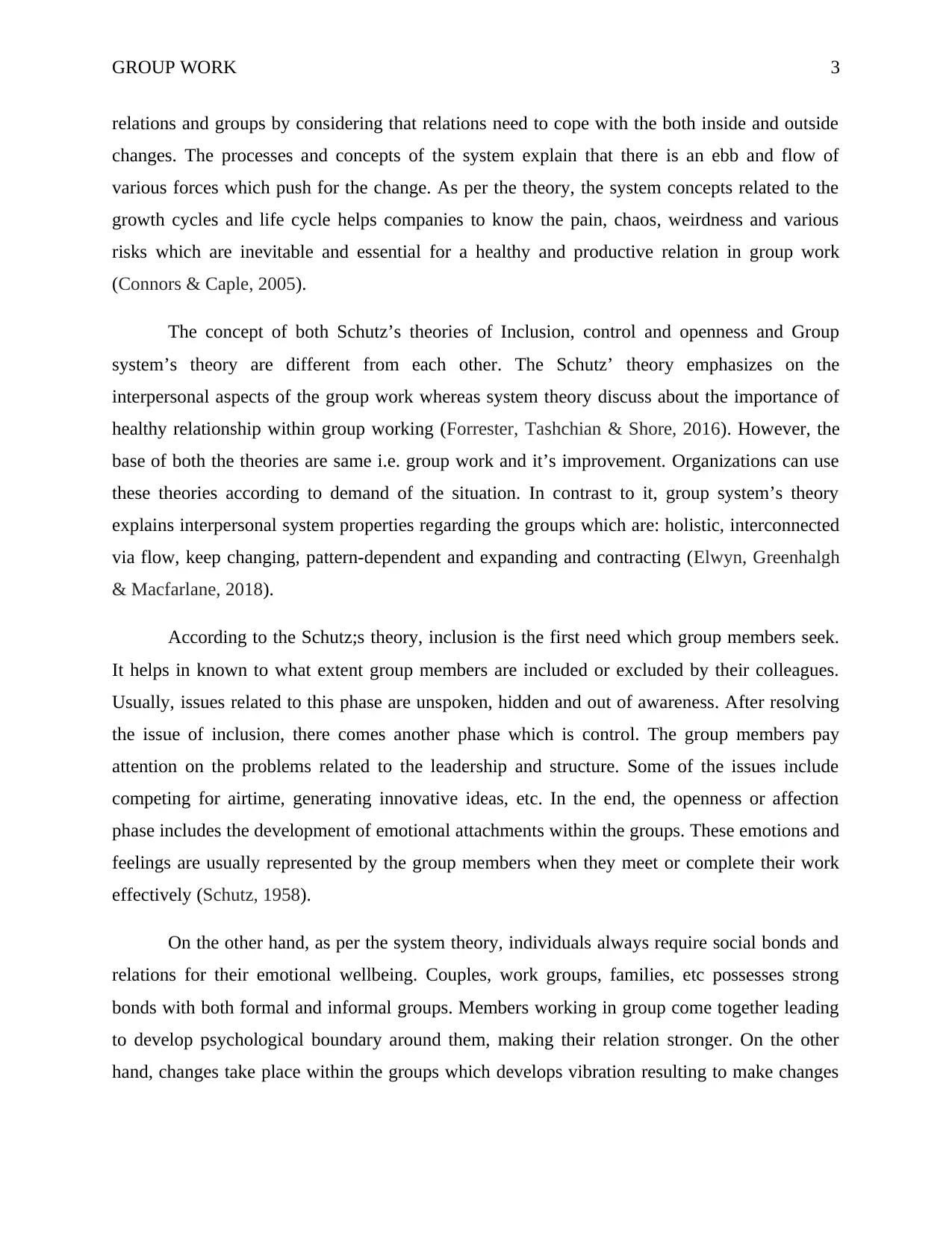
GROUP WORK 3
relations and groups by considering that relations need to cope with the both inside and outside
changes. The processes and concepts of the system explain that there is an ebb and flow of
various forces which push for the change. As per the theory, the system concepts related to the
growth cycles and life cycle helps companies to know the pain, chaos, weirdness and various
risks which are inevitable and essential for a healthy and productive relation in group work
(Connors & Caple, 2005).
The concept of both Schutz’s theories of Inclusion, control and openness and Group
system’s theory are different from each other. The Schutz’ theory emphasizes on the
interpersonal aspects of the group work whereas system theory discuss about the importance of
healthy relationship within group working (Forrester, Tashchian & Shore, 2016). However, the
base of both the theories are same i.e. group work and it’s improvement. Organizations can use
these theories according to demand of the situation. In contrast to it, group system’s theory
explains interpersonal system properties regarding the groups which are: holistic, interconnected
via flow, keep changing, pattern-dependent and expanding and contracting (Elwyn, Greenhalgh
& Macfarlane, 2018).
According to the Schutz;s theory, inclusion is the first need which group members seek.
It helps in known to what extent group members are included or excluded by their colleagues.
Usually, issues related to this phase are unspoken, hidden and out of awareness. After resolving
the issue of inclusion, there comes another phase which is control. The group members pay
attention on the problems related to the leadership and structure. Some of the issues include
competing for airtime, generating innovative ideas, etc. In the end, the openness or affection
phase includes the development of emotional attachments within the groups. These emotions and
feelings are usually represented by the group members when they meet or complete their work
effectively (Schutz, 1958).
On the other hand, as per the system theory, individuals always require social bonds and
relations for their emotional wellbeing. Couples, work groups, families, etc possesses strong
bonds with both formal and informal groups. Members working in group come together leading
to develop psychological boundary around them, making their relation stronger. On the other
hand, changes take place within the groups which develops vibration resulting to make changes
relations and groups by considering that relations need to cope with the both inside and outside
changes. The processes and concepts of the system explain that there is an ebb and flow of
various forces which push for the change. As per the theory, the system concepts related to the
growth cycles and life cycle helps companies to know the pain, chaos, weirdness and various
risks which are inevitable and essential for a healthy and productive relation in group work
(Connors & Caple, 2005).
The concept of both Schutz’s theories of Inclusion, control and openness and Group
system’s theory are different from each other. The Schutz’ theory emphasizes on the
interpersonal aspects of the group work whereas system theory discuss about the importance of
healthy relationship within group working (Forrester, Tashchian & Shore, 2016). However, the
base of both the theories are same i.e. group work and it’s improvement. Organizations can use
these theories according to demand of the situation. In contrast to it, group system’s theory
explains interpersonal system properties regarding the groups which are: holistic, interconnected
via flow, keep changing, pattern-dependent and expanding and contracting (Elwyn, Greenhalgh
& Macfarlane, 2018).
According to the Schutz;s theory, inclusion is the first need which group members seek.
It helps in known to what extent group members are included or excluded by their colleagues.
Usually, issues related to this phase are unspoken, hidden and out of awareness. After resolving
the issue of inclusion, there comes another phase which is control. The group members pay
attention on the problems related to the leadership and structure. Some of the issues include
competing for airtime, generating innovative ideas, etc. In the end, the openness or affection
phase includes the development of emotional attachments within the groups. These emotions and
feelings are usually represented by the group members when they meet or complete their work
effectively (Schutz, 1958).
On the other hand, as per the system theory, individuals always require social bonds and
relations for their emotional wellbeing. Couples, work groups, families, etc possesses strong
bonds with both formal and informal groups. Members working in group come together leading
to develop psychological boundary around them, making their relation stronger. On the other
hand, changes take place within the groups which develops vibration resulting to make changes
⊘ This is a preview!⊘
Do you want full access?
Subscribe today to unlock all pages.

Trusted by 1+ million students worldwide
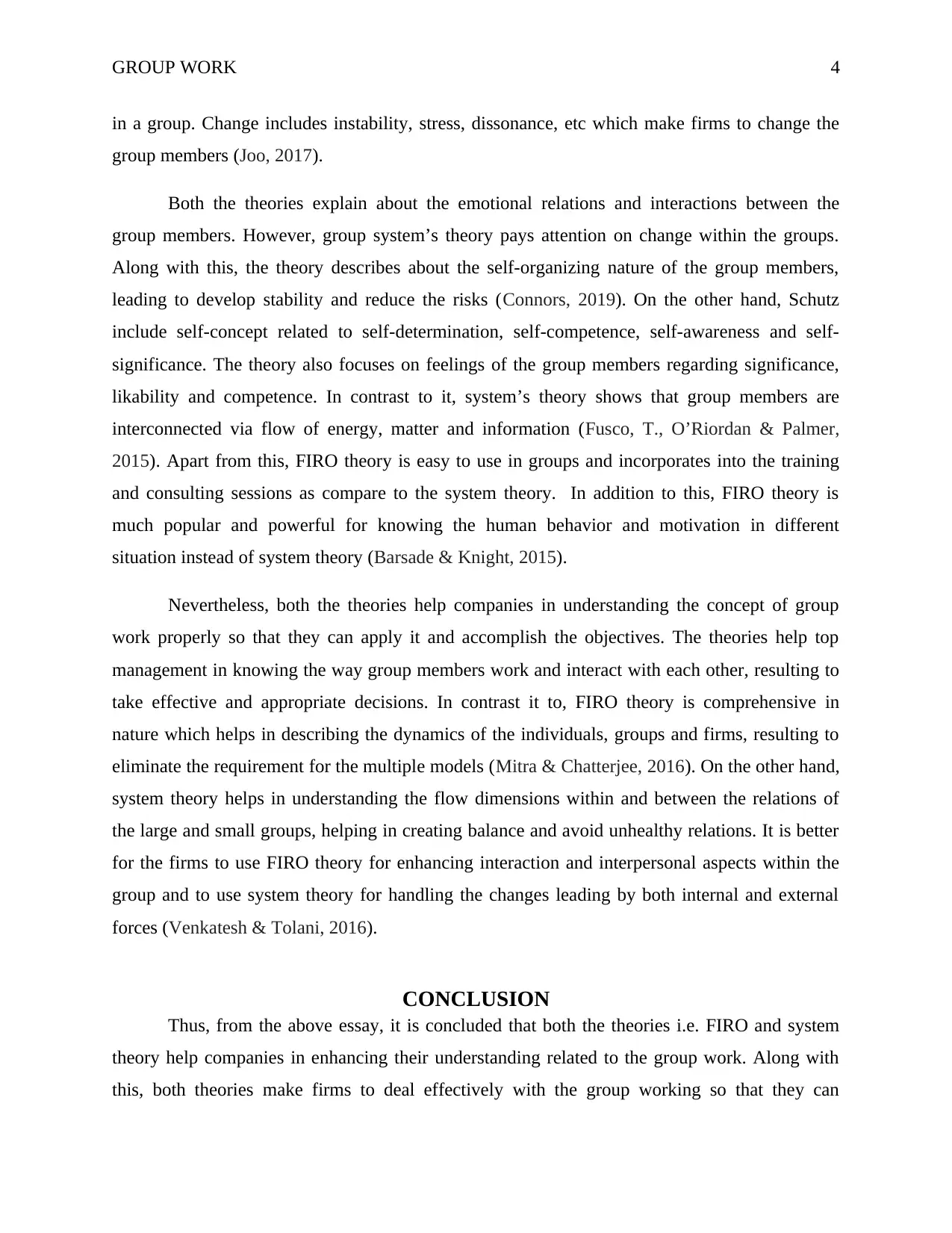
GROUP WORK 4
in a group. Change includes instability, stress, dissonance, etc which make firms to change the
group members (Joo, 2017).
Both the theories explain about the emotional relations and interactions between the
group members. However, group system’s theory pays attention on change within the groups.
Along with this, the theory describes about the self-organizing nature of the group members,
leading to develop stability and reduce the risks (Connors, 2019). On the other hand, Schutz
include self-concept related to self-determination, self-competence, self-awareness and self-
significance. The theory also focuses on feelings of the group members regarding significance,
likability and competence. In contrast to it, system’s theory shows that group members are
interconnected via flow of energy, matter and information (Fusco, T., O’Riordan & Palmer,
2015). Apart from this, FIRO theory is easy to use in groups and incorporates into the training
and consulting sessions as compare to the system theory. In addition to this, FIRO theory is
much popular and powerful for knowing the human behavior and motivation in different
situation instead of system theory (Barsade & Knight, 2015).
Nevertheless, both the theories help companies in understanding the concept of group
work properly so that they can apply it and accomplish the objectives. The theories help top
management in knowing the way group members work and interact with each other, resulting to
take effective and appropriate decisions. In contrast it to, FIRO theory is comprehensive in
nature which helps in describing the dynamics of the individuals, groups and firms, resulting to
eliminate the requirement for the multiple models (Mitra & Chatterjee, 2016). On the other hand,
system theory helps in understanding the flow dimensions within and between the relations of
the large and small groups, helping in creating balance and avoid unhealthy relations. It is better
for the firms to use FIRO theory for enhancing interaction and interpersonal aspects within the
group and to use system theory for handling the changes leading by both internal and external
forces (Venkatesh & Tolani, 2016).
CONCLUSION
Thus, from the above essay, it is concluded that both the theories i.e. FIRO and system
theory help companies in enhancing their understanding related to the group work. Along with
this, both theories make firms to deal effectively with the group working so that they can
in a group. Change includes instability, stress, dissonance, etc which make firms to change the
group members (Joo, 2017).
Both the theories explain about the emotional relations and interactions between the
group members. However, group system’s theory pays attention on change within the groups.
Along with this, the theory describes about the self-organizing nature of the group members,
leading to develop stability and reduce the risks (Connors, 2019). On the other hand, Schutz
include self-concept related to self-determination, self-competence, self-awareness and self-
significance. The theory also focuses on feelings of the group members regarding significance,
likability and competence. In contrast to it, system’s theory shows that group members are
interconnected via flow of energy, matter and information (Fusco, T., O’Riordan & Palmer,
2015). Apart from this, FIRO theory is easy to use in groups and incorporates into the training
and consulting sessions as compare to the system theory. In addition to this, FIRO theory is
much popular and powerful for knowing the human behavior and motivation in different
situation instead of system theory (Barsade & Knight, 2015).
Nevertheless, both the theories help companies in understanding the concept of group
work properly so that they can apply it and accomplish the objectives. The theories help top
management in knowing the way group members work and interact with each other, resulting to
take effective and appropriate decisions. In contrast it to, FIRO theory is comprehensive in
nature which helps in describing the dynamics of the individuals, groups and firms, resulting to
eliminate the requirement for the multiple models (Mitra & Chatterjee, 2016). On the other hand,
system theory helps in understanding the flow dimensions within and between the relations of
the large and small groups, helping in creating balance and avoid unhealthy relations. It is better
for the firms to use FIRO theory for enhancing interaction and interpersonal aspects within the
group and to use system theory for handling the changes leading by both internal and external
forces (Venkatesh & Tolani, 2016).
CONCLUSION
Thus, from the above essay, it is concluded that both the theories i.e. FIRO and system
theory help companies in enhancing their understanding related to the group work. Along with
this, both theories make firms to deal effectively with the group working so that they can
Paraphrase This Document
Need a fresh take? Get an instant paraphrase of this document with our AI Paraphraser
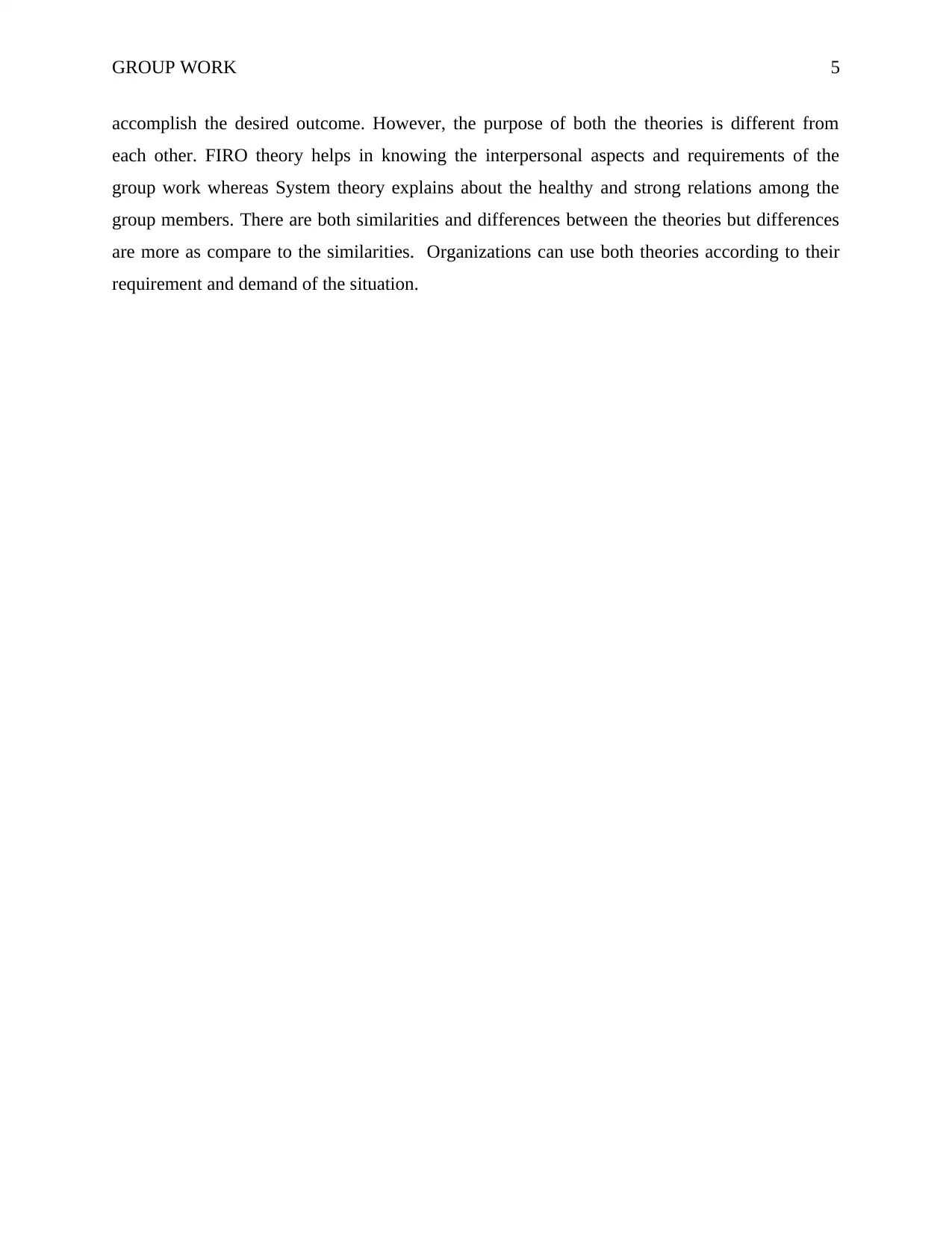
GROUP WORK 5
accomplish the desired outcome. However, the purpose of both the theories is different from
each other. FIRO theory helps in knowing the interpersonal aspects and requirements of the
group work whereas System theory explains about the healthy and strong relations among the
group members. There are both similarities and differences between the theories but differences
are more as compare to the similarities. Organizations can use both theories according to their
requirement and demand of the situation.
accomplish the desired outcome. However, the purpose of both the theories is different from
each other. FIRO theory helps in knowing the interpersonal aspects and requirements of the
group work whereas System theory explains about the healthy and strong relations among the
group members. There are both similarities and differences between the theories but differences
are more as compare to the similarities. Organizations can use both theories according to their
requirement and demand of the situation.
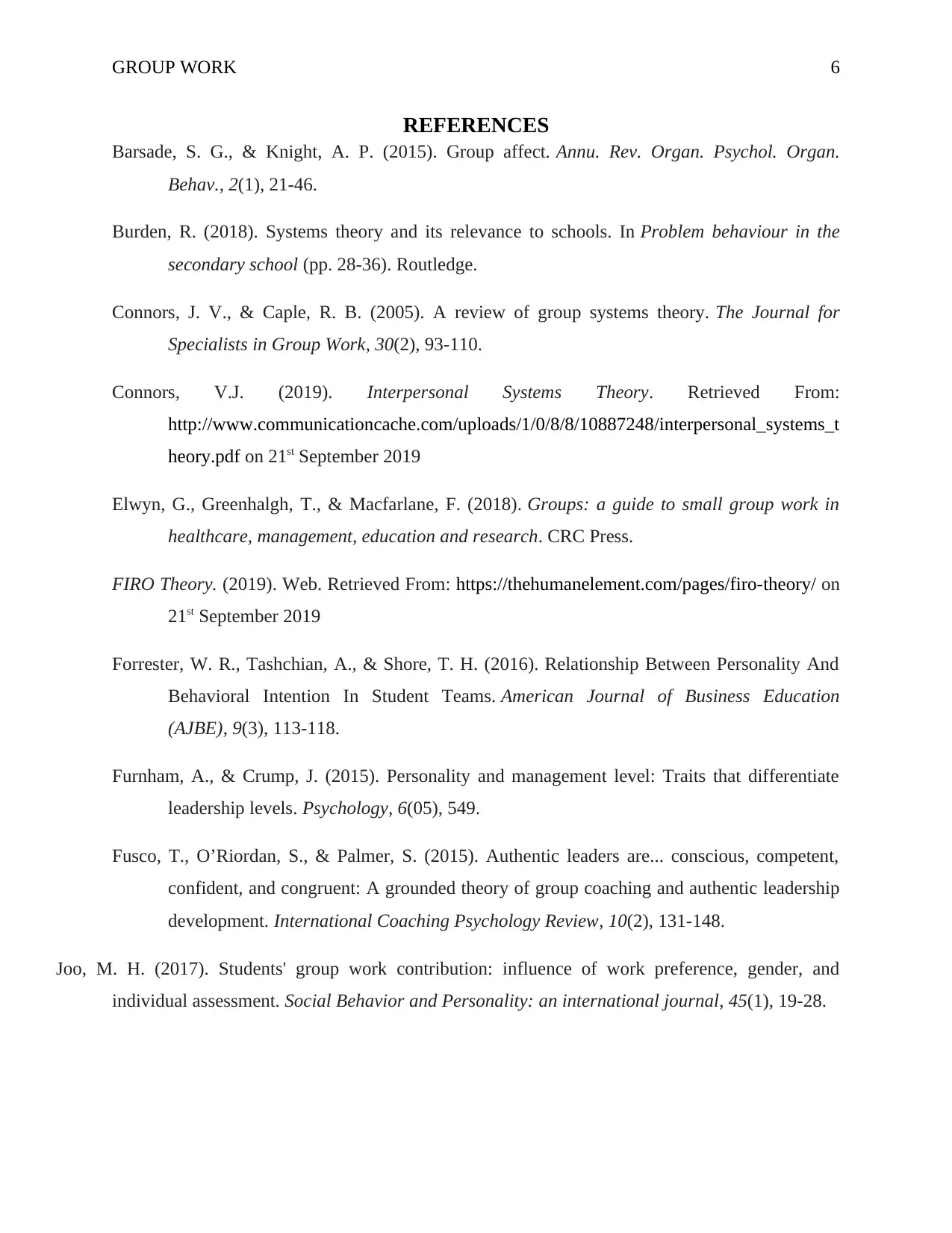
GROUP WORK 6
REFERENCES
Barsade, S. G., & Knight, A. P. (2015). Group affect. Annu. Rev. Organ. Psychol. Organ.
Behav., 2(1), 21-46.
Burden, R. (2018). Systems theory and its relevance to schools. In Problem behaviour in the
secondary school (pp. 28-36). Routledge.
Connors, J. V., & Caple, R. B. (2005). A review of group systems theory. The Journal for
Specialists in Group Work, 30(2), 93-110.
Connors, V.J. (2019). Interpersonal Systems Theory. Retrieved From:
http://www.communicationcache.com/uploads/1/0/8/8/10887248/interpersonal_systems_t
heory.pdf on 21st September 2019
Elwyn, G., Greenhalgh, T., & Macfarlane, F. (2018). Groups: a guide to small group work in
healthcare, management, education and research. CRC Press.
FIRO Theory. (2019). Web. Retrieved From: https://thehumanelement.com/pages/firo-theory/ on
21st September 2019
Forrester, W. R., Tashchian, A., & Shore, T. H. (2016). Relationship Between Personality And
Behavioral Intention In Student Teams. American Journal of Business Education
(AJBE), 9(3), 113-118.
Furnham, A., & Crump, J. (2015). Personality and management level: Traits that differentiate
leadership levels. Psychology, 6(05), 549.
Fusco, T., O’Riordan, S., & Palmer, S. (2015). Authentic leaders are... conscious, competent,
confident, and congruent: A grounded theory of group coaching and authentic leadership
development. International Coaching Psychology Review, 10(2), 131-148.
Joo, M. H. (2017). Students' group work contribution: influence of work preference, gender, and
individual assessment. Social Behavior and Personality: an international journal, 45(1), 19-28.
REFERENCES
Barsade, S. G., & Knight, A. P. (2015). Group affect. Annu. Rev. Organ. Psychol. Organ.
Behav., 2(1), 21-46.
Burden, R. (2018). Systems theory and its relevance to schools. In Problem behaviour in the
secondary school (pp. 28-36). Routledge.
Connors, J. V., & Caple, R. B. (2005). A review of group systems theory. The Journal for
Specialists in Group Work, 30(2), 93-110.
Connors, V.J. (2019). Interpersonal Systems Theory. Retrieved From:
http://www.communicationcache.com/uploads/1/0/8/8/10887248/interpersonal_systems_t
heory.pdf on 21st September 2019
Elwyn, G., Greenhalgh, T., & Macfarlane, F. (2018). Groups: a guide to small group work in
healthcare, management, education and research. CRC Press.
FIRO Theory. (2019). Web. Retrieved From: https://thehumanelement.com/pages/firo-theory/ on
21st September 2019
Forrester, W. R., Tashchian, A., & Shore, T. H. (2016). Relationship Between Personality And
Behavioral Intention In Student Teams. American Journal of Business Education
(AJBE), 9(3), 113-118.
Furnham, A., & Crump, J. (2015). Personality and management level: Traits that differentiate
leadership levels. Psychology, 6(05), 549.
Fusco, T., O’Riordan, S., & Palmer, S. (2015). Authentic leaders are... conscious, competent,
confident, and congruent: A grounded theory of group coaching and authentic leadership
development. International Coaching Psychology Review, 10(2), 131-148.
Joo, M. H. (2017). Students' group work contribution: influence of work preference, gender, and
individual assessment. Social Behavior and Personality: an international journal, 45(1), 19-28.
⊘ This is a preview!⊘
Do you want full access?
Subscribe today to unlock all pages.

Trusted by 1+ million students worldwide
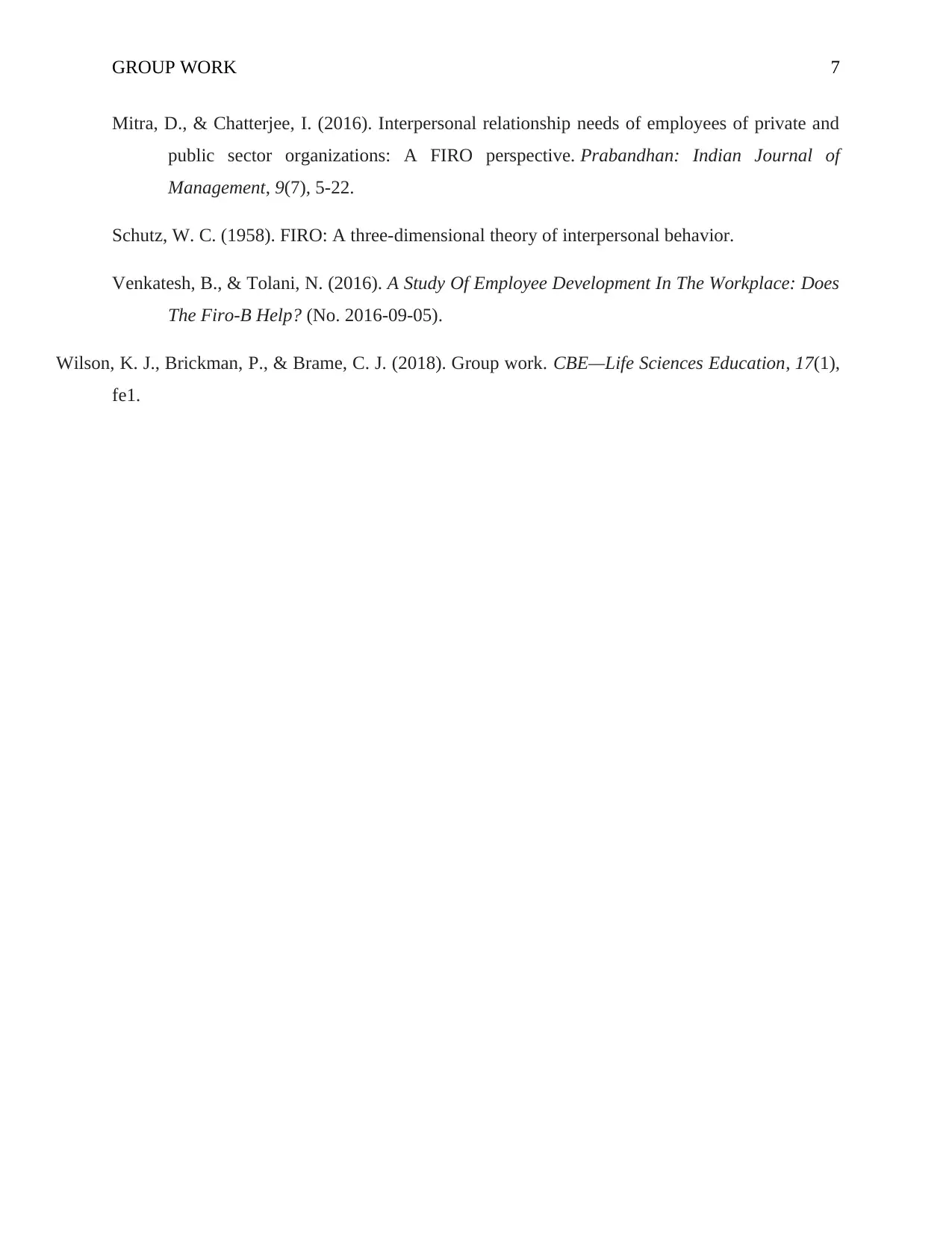
GROUP WORK 7
Mitra, D., & Chatterjee, I. (2016). Interpersonal relationship needs of employees of private and
public sector organizations: A FIRO perspective. Prabandhan: Indian Journal of
Management, 9(7), 5-22.
Schutz, W. C. (1958). FIRO: A three-dimensional theory of interpersonal behavior.
Venkatesh, B., & Tolani, N. (2016). A Study Of Employee Development In The Workplace: Does
The Firo-B Help? (No. 2016-09-05).
Wilson, K. J., Brickman, P., & Brame, C. J. (2018). Group work. CBE—Life Sciences Education, 17(1),
fe1.
Mitra, D., & Chatterjee, I. (2016). Interpersonal relationship needs of employees of private and
public sector organizations: A FIRO perspective. Prabandhan: Indian Journal of
Management, 9(7), 5-22.
Schutz, W. C. (1958). FIRO: A three-dimensional theory of interpersonal behavior.
Venkatesh, B., & Tolani, N. (2016). A Study Of Employee Development In The Workplace: Does
The Firo-B Help? (No. 2016-09-05).
Wilson, K. J., Brickman, P., & Brame, C. J. (2018). Group work. CBE—Life Sciences Education, 17(1),
fe1.
1 out of 7
Related Documents
Your All-in-One AI-Powered Toolkit for Academic Success.
+13062052269
info@desklib.com
Available 24*7 on WhatsApp / Email
![[object Object]](/_next/static/media/star-bottom.7253800d.svg)
Unlock your academic potential
Copyright © 2020–2025 A2Z Services. All Rights Reserved. Developed and managed by ZUCOL.





